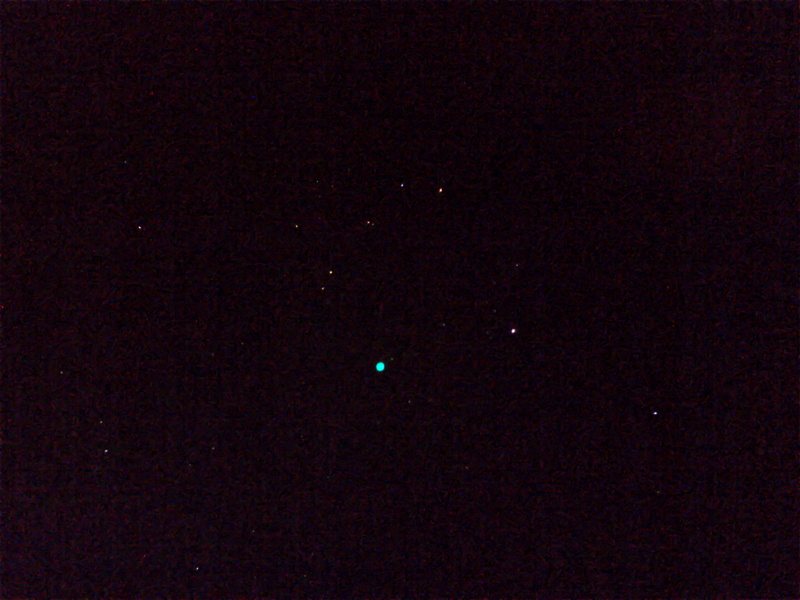iPhone NightCap Pro: M13, Blue Snowball, Neptune, Uranus Moons;
Critters
Posted: 14 October 2015
Saturday, 10 October 2015, started cloudy and windy. I went to Oracle State Park, our local IDA "International Dark Sky Park", for a day of activities, including a star party that night. You can read the report here.
Sunday, 11 October, dawned clear, but by midday the sky was hazy with some clouds. Cloudy skies continued on Monday, 12 October, but Tuesday dawned clear.
|
Open: Tuesday, 13 October 2015, 1810 MST Temperature: 89°F |
Session: 867 Conditions: Mostly clear, some clouds in north, hazy |
1817 MST: viewed Saturn, low in the southwest, 83X and 222X. A pretty good view at 222X. 1832 MST: Saturn moons Tethys, Rhea, Dione, and Titan visible, 83X.
1850 MST: viewed M13 (Great Globular Cluster in Hercules), 83X. Took this handheld afocal 77X photo (full-frame), iPhone 5s, NightCap Pro (Light Boost, ISO 8000, 1/2sec):

1920 MST: saw that my visitor (Giant Crab Spider) was back in the observatory again this night.
1931 MST: viewed Uranus, then Neptune, 83X. Switched to 222X for Neptune; nice disk visible. Mounted the iPhone 5s on the 8" LX200-ACF using my new Orion SteadyPix afocal adapter (review still in progress). This afocal 77X photo (full-frame) with NightCap Pro (Light Boost, ISO 8000, 1/2sec):

2010 MST: removed the iPhone and did a tour of Deep Sky Objects (DSOs) in the constellation of Andromeda, 83X: M110, M32, M31 (galaxies), NGC752 (open star cluster), NGC891 (galaxy), and NGC7662 (Blue Snowball, planetary nebula). Switched to 222X for the Blue Snowball; good view.
Mounted the iPhone using the SteadyPix for this full-frame, afocal 77X, image using NightCap Pro (Long Exposure, Light Boost, ISO 8000, 1/2sec, 5 seconds):

My visitor seemed to like to stay near where I was in the observatory so I took this photo:

I then noticed that I had another visitor:

2049 MST: viewed M33 (Triangulum Galaxy), 83X. Another nice view. I then did a tour of DSOs in the contellation of Cetus, 83X: NGC246 (planetary nebula), NGC247 (galaxy), IC1613 (galaxy), and M77 (galaxy).
2109 MST: viewed M45 (the Pleiades, open cluster), 83X. Although it was low in the east it was still a nice view.
2112 MST: slewed back to Uranus; good view at 83X. 2127 MST: setup for iPhone afocal imaging using the SteadyPix. This iPhone screen capture shows three of the moons of Uranus in SkySafari Pro:

This cropped image, afocal 77X, using NightCap Pro (Long Exposure, Light Boost, ISO 8000, 1/2sec, 10 seconds) shows the three moons:

Amazing that a smartphone camera could capture the moons of Uranus.
I removed the iPhone and mounted the D7200 DSLR at prime focus and took this 20 seconds, ISO 6400, cropped image of Uranus to show the moons:

Mouseover or tap on image for labels
After I closed the dome I saw that a second Giant Crab Spider had joined his friend (or mate) and me in the observatory:

|
Close: Tuesday, 13 October 2015, 2210 MST Temperature: 71°F |
Session Length: 4h 08m Conditions: Clear |
Comments are welcome using Email. If you are on Twitter you can use the button below to tweet this report to your followers. Thanks.
Cassiopeia Observatory Home Page
Copyright ©2015 Michael L. Weasner / mweasner@me.com
URL = http://www.weasner.com/co/Reports/2015/10/14/index.html
